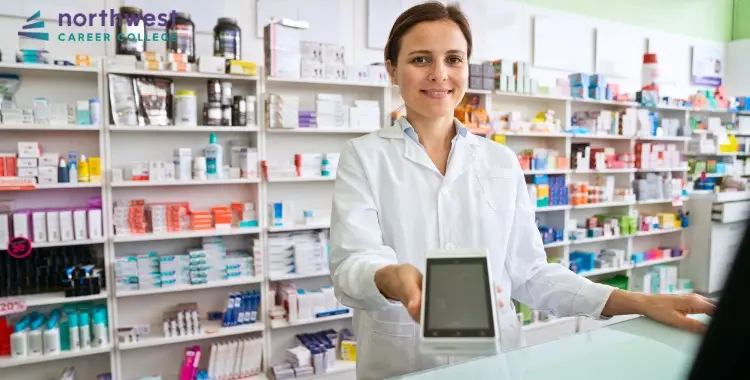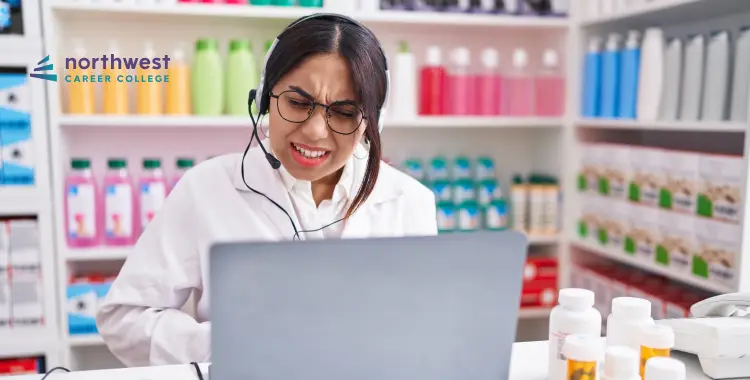How Technology is Changing the Role of Pharmacy Technicians
- February 28, 2025
- 4.2k views
- 5 min read
Are you considering a career as a pharmacy technician and wondering what the impact of technology will be on the pharmacy industry’s future? It is an excellent question before you start a training program that will prepare you to enter this field.
As can be observed in the rest of the healthcare industry, the role of the pharmacy technician is rapidly evolving due to technological advancements. This article will focus on opportunities and challenges created by technology for current and future technicians.

Table of Contents
Software Implementation
One of the overarching trends of the past 15 to 20 years is the incorporation of electronic health records and other software systems into the daily routines of healthcare workers. Pharmacy technicians are being exposed to this same technological trend.
Most modern pharmacies, if not all, have implemented pharmacy management software and positioned it to serve as the backbone of their business operations. Technicians must be able to use this software to manage incoming prescription requests, inventory, and other critical functions.
As pharmacy management software has evolved, so has its relationship with other software systems. These systems now integrate with electronic health records, allowing medical offices to transmit prescriptions to pharmacies for fulfillment directly. These systems also integrate with electronic billing software, allowing pharmacies to transmit insurance claims directly to insurance companies or third-party billing services.
Technicians must become proficient in using these systems to complete their daily assignments. However, the best technicians go beyond proficiency and seek to master the software to enhance their productivity and save time to complete other tasks now assigned to technicians.
Advanced Machinery Implementation
Pharmacy technicians, even more than some other areas of healthcare, are regularly confronted with the implementation of new machinery into their workflows. These machines can vastly improve efficiency when used correctly.
For example, automated pill-counting machines can significantly expedite the filling of a prescription. Other examples include machines that can automate the dispensing of flavors for liquid medication and enhanced dispensing cabinets that allow easier management of controlled substances. Large corporate pharmacies, like Pill Pack, owned by Amazon, have incorporated even more significant numbers of robotics and automation into their operation.
The time saved from this enhanced machinery provides technicians with more opportunities to expand their scope and skill set.
Expanding responsibilities
As mentioned above, technicians will spend less time on routine/repetitive tasks (E.g., Pill, counting), freeing up more of their time for more advanced tasks. Some examples of those more complex tasks include medication, therapy management, immunization administration, and medication reconciliation.
Medication therapy management represents a range of services pharmacy professionals provide to help improve patient health. These initiatives teach patients how to manage their medication if they are on multiple pharmaceuticals. Although pharmacists spearhead the services, pharmacy technicians are increasingly offering support to help optimize therapeutic outcomes for patients.
Immunization administration is an area of emerging interest in the pharmacy field. While immunizations have traditionally been administered in medical offices, they are increasingly administered by pharmacy technicians in the field. I’m sure many of you have seen the signs in your local grocery store or pharmacy encouraging you to get a flu shot, a COVID shot, or other supportive immunizations. This trend will likely continue and accelerate in the coming years.
Medication reconciliation has become an increasingly important task for pharmacy technicians. This process involves the intake of all current medications that a patient is taking. Then, that list is compared with all known prescriptions on file and the new prescription the pharmacy is being asked to fill.
By making this comparison, pharmacies proactively seek to identify drug duplication, dosing errors, or unanticipated drug interactions. These adverse outcomes can occur when a patient does not correctly disclose all current medications to their provider who is writing a prescription. Pharmacies are a backstop against incomplete or incorrect information offered to the prescribing provider.
Finally, Tech-Check-Tech programs represent a key area of increased responsibility due to the integration of technology in the pharmacy. In these programs, one technician verifies another’s work, freeing pharmacists for more complex tasks, such as overseeing medication therapy management initiatives.
Conclusion
As is evident above, the evolving role of a pharmacy technician, if coupled with proper training and support, could yield increased job satisfaction among pharmacy technicians. Technology can eliminate some of the more mundane and rote tasks completed by technicians and replace them with more exciting and fulfilling interactions with patients or other healthcare providers.
Additionally, there is an opportunity to provide more training and specialization within a pharmacy setting, paving the way for more significant career advancement and earning potential for pharmacy technicians. If these additional outcomes play out, technology will likely increase technicians’ job satisfaction.
Ultimately, pharmacy technicians will be unable to resist the technological changes underway. However, if they embrace these changes, they can expand their skill sets and become more integral in the healthcare system.




